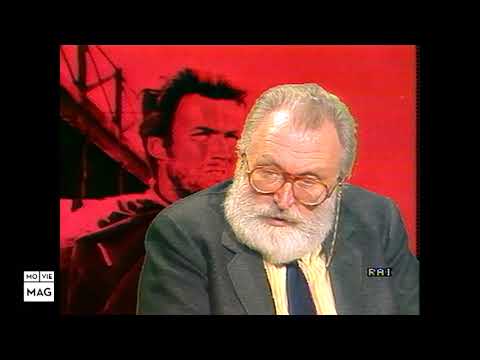Thanks for posting this, @Toscano
A brief summary: The interviewer introduces Leone as among the few Italian directors of absolute international prestige. He says he was born with Neorealism. Asked about his early experiences with cinema he talks about his father’s final film ‘La boca sulla strada’, and later working as an unpaid assistant on De Sica’s ‘Bicycle Thieves’. His alias Bob Robertson was a tribute to his father. He discusses his work on the chariot race for ‘Ben Hur’. He doesn’t consider himself the father of the Italian western as thirty films had already been made before ‘Fistful of Dollars’. He says he was unhappy with the costumes used in the film. He mentions seeing Clint Eastwood on ‘Rawhide’ and his dislike for cigars. And at the end he discusses the influence of ‘Yojimbo’ .
A little edit of the more interesting stuff:
Signor Leone, what did ‘Fistful of Dollars’ mean to you?
Well, it’s almost the silver anniversary, because it’s been twenty-two years since I’ve made the film. And so, the start of my career. A happy start because it was what I wanted to do.
I was born with Neorealism. And so I’ve always thought that cinema, in my opinion, was precisely the proposal into the adventure of myth. And through this to tell stories about certain little ghosts that each of us has inside.
What were your first experiences of cinema?
My very first experience was actually with my father. Which was the last film he made. And I was just 13 or 14 years old in Naples. It was called ‘La bocca sulla strada’. And the second, the real authentic one, was the one with De Sica, in ‘Bicycle Thieves’, where I was an unpaid assistant. And at the same time I also played a small role of a priest, which De Sica had ingeniously invented on the spot, and it was an authentic piece of poetry.
Ben Hur was recently on television. What did you do on that?
I was in charge of the second unit, that is, the chariot race together with Andrew Marton. Wyler shot the intimate scenes, so to speak, with the actors. And Wyler by contract, wanted and demanded, not to shoot even a metre of the chariot race. But to have the opportunity to reshoot the scene to the bitter end if he didn’t like it. And so we stayed in the field for about three months. And after a month and a half of rehearsals, the chariot race lasted almost as long as an entire film.
It’s said in Oreste De Fornari’s beautiful book that you do not like to be considered the father of the Italian Western. Why?
Well, I was considered the father of the Italian western without being so. Because thirty films had already been made before me. And by now the so-called commercial cinema had decreed it a total failure. The circuit had already exhausted all the vision of the pseudo American western.
So, what do you like most and what do you hate most - if there’s anything to hate about ‘Fistful of Dollars’?
‘Fistful of Dollars’ for me is the guiding film. That is, the one that gave me the opportunity to tell my cinema in a certain way, from a certain point of view. So I love it viscerally, I hate nothing. What I don’t like very much are the costumes. Because it’s a low-budget film, it cost 90 million. It took three countries to find 90 million. Thirty million per country: Germany, Italy and Spain.
How did you meet and choose Clint Eastwood?
Well, I saw Clint Eastwood on an old show called ‘Rawhide’. And so when I saw him, the thing that struck me most was the apathy. Because he didn’t speak, he was slow, apathetic, sleepy and he woke up only at the moment when he had to shoot. It was very fast, lightning fast. And so I thought of building this character around him, including the costume. The cigar was the first thing. In fact, I put this Toscano in his mouth, which was the closest cigar to the Virginia at the time. He didn’t smoke and suffered terribly. In fact, for the second film he told me: “Dear Sergio, with you I would make any film, without even reading the script, but not with a cigar in my mouth”. And I said to him: “But why do you want to leave one of the protagonists of the film at home?”
Another little thing as you know this week Network One also presents Kurosawa’s ‘Yojimbo’. A film that you said you were inspired by. What struck you the most and what are the differences between the two films?
But the thing that struck me the most was that ‘Yojimbo’ was taken from an American novel by Dashiell Hammett called ‘Red Harvest’. And then Kurosawa adapted it to his samurai film. So really, the primary thing was to bring it back to its homeland through cowboys, through a western. But then I have to say that all three including ‘Red Harvest’ have a different matrix. And the matrix is precisely ‘The Servant of Two Masters’. That is, a character who puts himself at the centre of two clans, sells himself to both without the two knowing it. And then undaunted he watches the conflict, having fun behind the backs of both.
